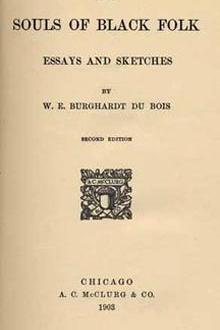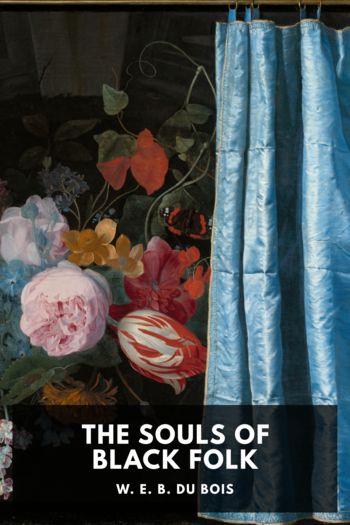The Souls of Black Folk by W. E. B. Du Bois (reading books for 5 year olds .TXT) 📖

- Author: W. E. B. Du Bois
- Performer: -
Book online «The Souls of Black Folk by W. E. B. Du Bois (reading books for 5 year olds .TXT) 📖». Author W. E. B. Du Bois
Thus it is that in the country districts of the South, by written or unwritten law, peonage, hindrances to the migration of labor, and a system of white patronage exists over large areas. Besides this, the chance for lawless oppression and illegal exactions is vastly greater in the country than in the city, and nearly all the more serious race disturbances of the last decade have arisen from disputes in the count between master and man,—as, for instance, the Sam Hose affair. As a result of such a situation, there arose, first, the Black Belt; and, second, the Migration to Town. The Black Belt was not, as many assumed, a movement toward fields of labor under more genial climatic conditions; it was primarily a huddling for self-protection,—a massing of the black population for mutual defence in order to secure the peace and tranquillity necessary to economic advance. This movement took place between Emancipation and 1880, and only partially accomplished the desired results. The rush to town since 1880 is the counter-movement of men disappointed in the economic opportunities of the Black Belt.
In Dougherty County, Georgia, one can see easily the results of this experiment in huddling for protection. Only ten per cent of the adult population was born in the county, and yet the blacks outnumber the whites four or five to one. There is undoubtedly a security to the blacks in their very numbers,—a personal freedom from arbitrary treatment, which makes hundreds of laborers cling to Dougherty in spite of low wages and economic distress. But a change is coming, and slowly but surely even here the agricultural laborers are drifting to town and leaving the broad acres behind. Why is this? Why do not the Negroes become landowners, and build up the black landed peasantry, which has for a generation and more been the dream of philanthropist and statesman?
To the car-window sociologist, to the man who seeks to understand and know the South by devoting the few leisure hours of a holiday trip to unravelling the snarl of centuries,—to such men very often the whole trouble with the black field-hand may be summed up by Aunt Ophelia’s word, “Shiftless!” They have noted repeatedly scenes like one I saw last summer. We were riding along the highroad to town at the close of a long hot day. A couple of young black fellows passed us in a muleteam, with several bushels of loose corn in the ear. One was driving, listlessly bent forward, his elbows on his knees,—a happy-go-lucky, careless picture of irrespon-sibility. The other was fast asleep in the bottom of the wagon.
As we passed we noticed an ear of corn fall from the wagon.
They never saw it,—not they. A rod farther on we noted another ear on the ground; and between that creeping mule and town we counted twenty-six ears of corn. Shiftless? Yes, the personification of shiftlessness. And yet follow those boys: they are not lazy; to-morrow morning they’ll be up with the sun; they work hard when they do work, and they work willingly. They have no sordid, selfish, money-getting ways, but rather a fine disdain for mere cash. They’ll loaf before your face and work behind your back with good-natured honesty. They’ll steal a watermelon, and hand you back your lost purse intact. Their great defect as laborers lies in their lack of incentive beyond the mere pleasure of physical exer-tion. They are careless because they have not found that it pays to be careful; they are improvident because the improvident ones of their acquaintance get on about as well as the provident. Above all, they cannot see why they should take unusual pains to make the white man’s land better, or to fatten his mule, or save his corn. On the other hand, the white landowner argues that any attempt to improve these laborers by increased responsibility, or higher wages, or better homes, or land of their own, would be sure to result in failure. He shows his Northern visitor the scarred and wretched land; the ruined mansions, the worn-out soil and mortgaged acres, and says, This is Negro freedom!
Now it happens that both master and man have just enough argument on their respective sides to make it difficult for them to understand each other. The Negro dimly personifies in the white man all his ills and misfortunes; if he is poor, it is because the white man seizes the fruit of his toil; if he is ignorant, it is because the white man gives him neither time nor facilities to learn; and, indeed, if any misfortune happens to him, it is because of some hidden machinations of “white folks.” On the other hand, the masters and the masters’ sons have never been able to see why the Negro, instead of settling down to he day-laborers for bread and clothes, are infected with a silly desire to rise in the world, and why they are sulky, dissatisfied, and careless, where their fathers were happy and dumb and faithful. “Why, you niggers have an easier time than I do,” said a puzzled Albany merchant to his black customer. “Yes,” he replied, “and so does yo’ hogs.”
Taking, then, the dissatisfied and shiftless field-hand as a starting-point, let us inquire how the black thousands of Dougherty have struggled from him up toward their ideal, and what that ideal is. All social struggle is evidenced by the rise, first of economic, then of social classes, among a homo-geneous population. To-day the following economic classes are plainly differentiated among these Negroes.
A “submerged tenth” of croppers, with a few paupers; forty per cent who are metayers and thirty-nine per cent of semi-metayers and wage-laborers. There are left five per cent of money-renters and six per cent of freeholders,—the “Upper Ten” of the land. The croppers are entirely without capital, even in the limited sense of food or money to keep them from seed-time to harvest. All they furnish is their labor; the landowner furnishes land, stock, tools, seed, and house; and at the end of the year the laborer gets from a third to a half of the crop. Out of his share, however, comes pay and interest for food and clothing advanced him during the year. Thus we have a laborer without capital and without wages, and an employer whose capital is largely his employees’ wages. It is an unsatisfactory arrangement, both for hirer and hired, and is usually in vogue on poor land with hard-pressed owners.
Above the croppers come the great mass of the black population who work the land on their own responsibility, paying rent in cotton and supported by the crop-mortgage system. After the war this system was attractive to the freedmen on account of its larger freedom and its possibility for making a surplus. But with the carrying out of the crop-lien system, the deterioration of the land, and the slavery of debt, the position of the metayers has sunk to a dead level of practically unrewarded toil. Formerly all tenants had some capital, and often considerable; but absentee landlordism, rising rack-rent, and failing cotton have stripped them well-nigh of all, and probably not over half of them to-day own their mules.
The change from cropper to tenant was accomplished by fixing the rent. If, now, the rent fixed was reasonable, this was an incentive to the tenant to strive. On the other hand, if the rent was too high, or if the land deteriorated, the result was to discourage and check the efforts of the black peasantry. There is no doubt that the latter case is true; that in Dougherty County every economic advantage of the price of cotton in market and of the strivings of the tenant has been taken advantage of by the landlords and merchants, and swallowed up in rent and interest. If cotton rose in price, the rent rose even higher; if cotton fell, the rent remained or followed reluctantly. If the tenant worked hard and raised a large crop, his rent was raised the next year; if that year the crop failed, his corn was confiscated and his mule sold for debt. There were, of course, exceptions to this,—cases of personal kindness and forbearance; but in the vast majority of cases the rule was to extract the uttermost farthing from the mass of the black farm laborers.
The average metayer pays from twenty to thirty per cent of his crop in rent. The result of such rack-rent can only be evil,—abuse and neglect of the soil, deterioration in the character of the laborers, and a widespread sense of injustice.
“Wherever the country is poor,” cried Arthur Young, “it is in the hands of metayers,” and “their condition is more wretched than that of day-laborers.” He was talking of Italy a century ago; but he might have been talking of Dougherty County to-day. And especially is that true to-day which he declares was true in France before the Revolution: “The metayers are considered as little better than menial servants, removable at pleasure, and obliged to conform in all things to the will of the landlords.” On this low plane half the black population of Dougherty County—perhaps more than half the black millions of this land—are to-day struggling.
A degree above these we may place those laborers who receive money wages for their work. Some receive a house with perhaps a garden-spot; then supplies of food and clothing are advanced, and certain fixed wages are given at the end of the year, varying from thirty to sixty dollars, out of which the supplies must be paid for, with interest. About eighteen per cent of the population belong to this class of semi-metayers, while twenty-two per cent are laborers paid by the month or year, and are either “furnished” by their own savings or perhaps more usually by some merchant who takes his chances of payment. Such laborers receive from thirty-five to fifty cents a day during the working season.
They are usually young unmarried persons, some being women; and when they marry they sink to the class of metayers, or, more seldom, become renters.
The renters for fixed money rentals are the first of the emerging classes, and form five per cent of the families. The sole advantage of this small class is their freedom to choose their crops, and the increased responsibility which comes through having money transactions. While some of the renters differ little in condition from the metayers, yet on the whole they are more intelligent and responsible persons, and are the ones who eventually become landowners. Their better character and greater shrewdness enable them to gain, perhaps to demand, better terms in rents; rented farms, varying from forty to a hundred acres, bear an average rental of about fifty-four dollars a year. The men who conduct such farms do not long remain renters; either they sink to metayers, or with a successful series of harvests rise to be landowners.
In 1870 the tax-books of Dougherty report no Negroes as landholders. If there were any such at that time,—and there may have been a few,—their land was probably held in the name of some white patron,—a method not uncommon during slavery. In 1875 ownership of land had begun with seven hundred and fifty acres; ten years later this had increased to over sixty-five hundred acres, to nine thousand acres in 1890 and ten thousand





Comments (0)